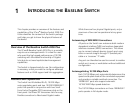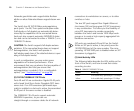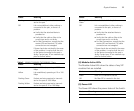
8 CHAPTER 1: INTRODUCING THE BASELINE SWITCH
SFP Ports
The two SFP ports support fiber Gigabit Ethernet
short-wave (SX) and long-wave (LX) SFP transceivers
in any combination. This offers you the flexibility of
using SFP transceivers to provide connectivity
between the Switch and a 1000 Mbps core network.
When an SFP port is in operation, the corresponding
10/100/1000BASE-T port is disabled.
Traffic Prioritization
The Switch offers priority queuing, which means all
packets that are received are examined to see if they
have been priority encoded. If a packet has been pri-
ority encoded, then the Switch will read the priority
level and determine whether the packet should be
directed through the normal or high priority channel.
This feature is useful during excessive loads when one
type of traffic may require priority over another. The
Switch is configured to comply with 802.1p, VLAN
tagged frames.
Traffic prioritization ensures that high priority data is
forwarded through the Switch without being delayed
by lower priority data. It differentiates traffic into
classes and prioritizes those classes automatically.
Traffic prioritization uses the multiple traffic queues
that are present in the hardware of the Switch to
ensure that high priority traffic is forwarded on a dif-
ferent queue from lower priority traffic, and is given
preference over that traffic. This ensures that
time-sensitive traffic gets the highest level of service.
The 802.1D standard specifies eight distinct levels of
priority (0 to 7), each of which relates to a particular
type of traffic. The priority levels and their traffic types
are shown in the following table.
Table 3 Priority Levels for Traffic Types
Forwarding of BPDU Packets
Within an extended local area network that imple-
ments a spanning tree protocol topology, switches
communicate with each other using bridge protocol
data unit (BPDU) packets.
If your network is implementing a spanning tree
topology across multiples switches, you can configure
3Com Baseline Switch 2250 Plus to forward or to
block and discard bridge protocol data unit (BPDU)
packets to another switch. Switches that support the
spanning tree protocol communicate with each other
using BPDU packets.
The spanning tree protocol (STP) is a mechanism that
prevents looping and broadcast storms. A spanning
tree uses the spanning tree algorithm to detect avail-
Priority Level Traffic Type
0 Best effort
1Background
2 Standard (spare)
3 Excellent effort (business critical)
4 Controlled load (streaming multimedia)
5 Video (interactive media), less than 100
milliseconds latency and jitter
6 Voice (interactive voice), less than 10 milli-
seconds latency and jitter.
7 Network control reserved traffic


















